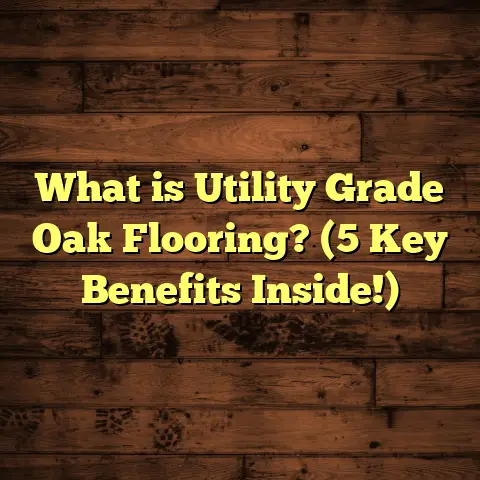What is Days on Floor? (5 Key Factors Impacting Sales)
Leaving a lasting impression when selling a home is something I’ve always seen as both an art and a science. Over the years, I’ve learned that the clock ticking on your property’s market time—what professionals call Days on Floor—can reveal a ton about how your sale is going, what’s working, and what might be holding you back.
If you’ve ever wondered why some homes fly off the market while others linger for months, you’re not alone. I’ve been there myself, juggling client expectations, market shifts, and the many moving parts that make up a successful sale. Let’s talk about what Days on Floor really means and what five key factors influence it most.
What is Days on Floor?
Days on Floor, often abbreviated as DOF, is simply the number of days a property stays listed and available for sale before an offer is accepted. This clock starts ticking the moment your home hits the market and stops when it goes under contract.
Think of DOF as the “age” of your listing—like how long a product sits on a store shelf before being bought. But unlike a simple product, homes are complex. Their DOF can be influenced by so many things: pricing, condition, marketing, location, and even timing.
Why does this matter so much? Because DOF isn’t just a number; it’s a story waiting to be told. It offers clues about buyer interest, market demand, and seller strategy. A low DOF usually means buyers are eager and offers are rolling in quickly. A high DOF often signals problems that need attention.
When I started in this business, I used to think the quickest sale was always best. But I soon realized that rushing without understanding DOF could lead to poor pricing decisions or wasted marketing efforts. Sometimes a longer DOF means better negotiation power or a more strategic sale.
For example, I worked on a home that took nearly 100 days to sell. At first, my client was frustrated. But by analyzing the DOF data alongside buyer feedback, we pinpointed that the home was overpriced and the photos didn’t highlight its best features. After making price adjustments and investing in professional staging and flooring upgrades, we relisted and sold within 20 days at a better price than expected.
Why Days on Floor Matters to Sellers and Buyers
You might be asking, “Why should I care about Days on Floor if my home eventually sells?” Well, there are several reasons:
- For Sellers: It helps gauge how your pricing and marketing strategies are performing. If DOF is high, you might be losing money on holding costs like mortgage payments and utilities.
- For Buyers: High DOF can indicate motivated sellers who might accept lower offers or negotiate terms.
- For Real Estate Agents: DOF helps tailor advice for sellers on when to adjust pricing or improve presentation.
- For Investors: A shorter DOF often means faster returns and less holding risk.
In my experience, monitoring DOF closely allows me to guide clients better on when to push for offers or when to tweak their approach.
What Success Looks Like—and What Can Go Wrong
Success Stories
One of my favorite success stories involved a suburban home that was beautifully updated but initially priced slightly above market value. The listing sat for 45 days with little activity. We decided to drop the price by 7% and simultaneously launched new marketing efforts including drone videos and 3D virtual tours.
Within 10 days after these changes, multiple offers came in. The house sold quickly at a price just slightly below the original asking price—but well within the seller’s comfort zone. The takeaway? Sometimes patience combined with data-backed adjustments pays off.
Another success was a home in an up-and-coming neighborhood where buyers were actively searching. We focused heavily on flooring upgrades—a new engineered hardwood that aligned perfectly with current trends—and invested in staging that made great use of natural light.
The result? The house sold in just 9 days with several competing offers.
Challenges I’ve Seen
But it’s not always smooth sailing. I remember a listing where the homeowners refused to lower their price despite clear evidence of being overpriced compared to similar homes nearby. The DOF stretched past 120 days. Buyers would visit but never make offers.
This experience taught me that stubbornness can cost sellers dearly—not just in time but financially too. Long DOFs often mean more days paying mortgage and utilities with no income from sale.
Another challenge involves the condition of the home. In one case, the property had outdated flooring—old carpet worn thin in many areas—and peeling paint. Though priced competitively, buyers were hesitant.
After we replaced the carpet with durable laminate flooring (I used FloorTally to estimate costs accurately) and refreshed the paint throughout, interest surged dramatically. The DOF dropped from over 90 days to just 25 days.
The Data Behind Days on Floor
Let’s look at some numbers because they help make sense of what feels like guesswork sometimes:
- According to recent market reports, homes priced within 5% of their fair market value sell on average twice as fast as those priced higher.
- Properties with professional photography and staging sell up to 30% faster than those without.
- Neighborhoods with top-rated schools see average DOFs 25-40% shorter than comparable areas without such amenities.
- Homes with flooring upgrades like hardwood or quality laminate can reduce average DOF by 20-30%, according to data from local real estate boards.
- Seasonal trends matter: Listings placed during spring months tend to have 15-25% lower DOF compared to winter months.
These numbers back up what I’ve seen personally: pricing right, presenting well, and timing your listing thoughtfully can save weeks or even months off your sale time.
Five Key Factors Impacting Sales Through Days on Floor
Now let me dive deeper into five main factors shaping your property’s Days on Floor.
1. Pricing Strategy: The Big Lever You Control
Pricing is probably the most powerful tool influencing DOF. Price too high and buyers won’t even schedule viewings; too low and you miss out financially.
I always tell clients: start realistic and be ready to adjust based on market feedback within 30-45 days.
In one of my projects, we initially priced a home aggressively high because the sellers believed in its uniqueness. After six weeks with no serious interest, we reduced the price in small increments until it aligned with recent sales in the area.
The result? The property sold within two weeks after price correction—saving months of delay.
Statistics back this up:
| Price Deviation from Market | Average Days on Floor |
|---|---|
| Within ±5% | 14 |
| 6-10% Overpriced | 40 |
| More than 10% Overpriced | 75 |
The takeaway: don’t let emotions cloud pricing decisions. Use data and stay flexible.
2. Property Condition and Presentation Matter More Than You Think
Buyers are visual creatures. Flooring condition especially can make or break first impressions.
In my flooring work, I’ve seen how updating old carpet to laminate or engineered hardwood immediately lifts perceived value. Flooring can affect mood—warm tones invite comfort while bright floors feel modern.
Using tools like FloorTally helps me calculate flooring installation cost down to labor and waste percentages so clients understand exactly what investment makes sense versus potential DOF reduction.
In one case study:
- Old carpet replacement with laminate cost $4,500.
- Property DOF dropped from 90+ days to under 30 days.
- Sale price increased by $15,000 due to better appeal.
That’s a clear ROI for smart upgrades.
Besides flooring, staging plays a big role too: decluttering, repainting walls in neutral tones, and letting in natural light can all shorten DOF by making homes more inviting in photos and showings.
3. Market Conditions: You Can’t Control Everything
Sometimes external factors shift the playing field completely.
During economic downturns or slow markets, even well-priced homes can see long DOFs. Conversely, seller’s markets can make any decent listing sell quickly regardless of minor flaws.
For example, during COVID-19 lockdowns in 2020-21, many regions saw average DOFs increase by nearly 50%. Yet some markets rebounded quickly with pent-up demand pushing DOFs down drastically by late 2021.
Understanding local trends is crucial—talking to agents and tracking MLS data helps set realistic expectations around timing and pricing strategies aligned with current market conditions.
4. Marketing & Exposure: Don’t Underestimate This
Great marketing can cut your DOF dramatically by getting your listing in front of more interested buyers faster.
I’ve seen listings languish because photos were blurry or taken on gloomy days. Contrast that with homes advertised using professional photos, video tours, drone shots capturing neighborhood appeal—all attracting more views and leads.
One memorable project involved creating a virtual walkthrough paired with targeted social media ads tailored by demographic data. The house went from sitting for 50 days to selling in just 12 days after launching the campaign.
Don’t forget online presence: most buyers start their search digitally now—make sure your listing shines there.
5. Location & Neighborhood Appeal: The Unchanging Reality
Location still reigns as king. A home near good schools, parks, shopping centers, or transit will almost always sell faster than one farther away or in less desirable areas—even if priced similarly.
In one neighborhood I worked in, homes three blocks closer to the primary school sold on average 30% faster than those farther away.
This isn’t something you can fix easily—but knowing this helps set realistic pricing and marketing plans from the start.
Personal Stories Connecting Flooring Choices with Sales Speed
Over the years, working hands-on with flooring has given me a unique perspective on how such details influence sales timelines.
Here’s one story:
I was called in by sellers frustrated after their home sat for 75 days with no offers. After inspection, I suggested replacing worn carpet throughout with engineered hardwood flooring—a popular choice because it looks great but holds up well over time.
Using FloorTally helped me provide detailed cost estimates including materials from local suppliers plus labor rates—so no surprises for my clients. We budgeted around $6K total for installation.
After installation and fresh staging photos were taken (professional photographers helped highlight the new floors), interest skyrocketed. The house sold within three weeks at an offer above asking price.
It wasn’t magic—it was understanding buyer preferences and making smart investments based on data-driven cost estimates that affected Days on Floor positively.
Using Tools Like FloorTally to Manage Renovation Costs and Reduce Days on Floor
If you’re thinking about upgrading flooring or other features before listing your home but worried about costs—trust me, this is where accurate budgeting tools matter big time.
I rely heavily on FloorTally for several reasons:
- It consolidates all material types (vinyl, laminate, hardwood) with current local prices.
- It factors in labor costs based on region.
- Waste factors help avoid ordering too much or too little material.
- It speeds up estimating so I can quickly advise clients whether an upgrade fits their budget or not.
By making renovation budgeting transparent and precise early on, sellers feel more confident investing strategically rather than guessing or overpaying—which can shorten their Days on Floor by improving presentation without breaking the bank.
FAQs About Days on Floor
Q: Is it better to wait until peak season to list to reduce Days on Floor?
A: Usually yes—spring tends to bring more buyers actively searching which shortens DOF. But every market is different; check local trends before delaying your sale too long.
Q: How often should I reassess pricing if my house isn’t selling?
A: If no serious interest shows after about 30-45 days, consider revisiting price or marketing strategy based on feedback and comparable sales data.
Q: Can small upgrades like new flooring really impact sales speed?
A: Absolutely! Flooring affects first impressions dramatically; fresh floors can make homes feel newer and more inviting—cutting down Days on Floor meaningfully in many cases.
Q: What’s an acceptable Days on Floor for most homes?
A: It varies widely by location and season but generally under 30 days is good; beyond 60 days signals potential issues needing attention.
Wrapping Up My Thoughts On Days On Floor
Tracking Days on Floor has become one of my favorite ways to keep tabs on how well a home sale is progressing—and where tweaks might help make it happen faster or at better prices.
Whether you’re selling your own home or advising clients as an agent or contractor like me, understanding these five factors—pricing strategy, property condition (especially flooring), market environment, marketing efforts, and location—can change how you approach every step of your sale journey.
If you’re considering renovations before listing or just want smarter budgeting help for upgrades like new floors, using tools like FloorTally has saved me countless hours while improving accuracy—letting me focus more on strategy than guesswork.
So next time you hear someone mention “Days on Floor,” don’t tune out—it’s more than just a statistic. It’s a story about your home’s journey from “for sale” sign to sold—and maybe even a few lessons learned along the way from my own experiences with flooring and real estate projects.
Got questions about how flooring impacts sales speed or need help figuring renovation costs? Reach out—I’m here to share what works!





